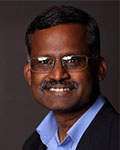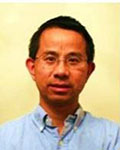Chockkalingam Karuppaiah
Biography
Chockkalingam (Chock) Karuppaiah received his Bachelor’s Degree in Chemical and Electrochemical Engineering from the Central Electrochemical Research Institute (CECRI), India (1993), and PhD in Electrochemistry and Fuel Cells from Rensselaer Polytechnic Institute (RPI), Troy, NY (1997). Chock’s professional experience includes being vice president of fuel cell stack engineering at Bloom Energy, founder at EC Labs, research professor at Case Western Reserve University, manager of fundamentals team at Plug Power, and graduate research assistant at Los Alamos National Lab. The products he developed include polymer electrolyte fuel cells, flow batteries, and solid oxide fuel cells. In his professional tenure, he was part of the design, development, and manufacturing scale up of seven different products. Chock has authored 19 published patents with several pending, and over 12 publications and presentations in scientific journals and societies. To enable massive scaling and adaptation of electrochemical technologies in support of decarbonization, Chock recently founded Vetri Labs, an electrochemical research, consulting, and testing services firm.
Statement of Candidacy
My most recent membership in ECS has been since July of 2018, and I have attended and presented in ECS meetings. I have always been a member of IE&EE division, as I strongly believe the need for advances in electrochemical engineering in translating concepts to products. Having been in industry almost all my professional life, I hope to bring industry perspective to the division. With the advances in renewable energy making the cost of electricity inexpensive, the economics of electrochemical ways of generating chemicals become very attractive. This will need the development and application of electrochemical engineering, working with professionals from across the disciplines. I will work with the rest of the IE&EE team in helping organize symposia with participation from industry and systems engineering teams. To spread the word of electrochemical engineering work with the rest of the electrochemical community, I volunteered and now represent IE&EE division as part of Interface Tech Highlights team. I look forward to getting your support and in serving the IE&EE division.
Paul J. A. Kenis
Biography
Paul J. A. Kenis is a professor of chemical and biomolecular engineering at the University of Illinois at Urbana-Champaign (UIUC). Kenis, a native of the Netherlands, received his BS Degree in Chemistry from Nijmegen Radboud University, where he worked on model systems for metalloproteins, and his PhD in Chemical Engineering at the University of Twente, working on films for nonlinear optical applications. As a postdoc at Harvard, he explored the then emerging area of microfluidics and its application to analytical chemistry. In his independent career at UIUC, he develops microchemical systems for applications in energy conversion and biology. For example, he pioneered membraneless microfluidic fuel cells that minimize or eliminate issues such fuel crossover, water management, and electrolyte restrictions. His work on efficient alkaline, air-breathing membraneless fuel cells led to a startup company, INI Power Systems. Around 2009, he was one of the first to investigate electrocatalytic reduction of CO2 to value-added intermediates using gas diffusion electrodes to overcome mass transport issues. Since then, Kenis’ research has focused on improving catalysts, electrodes, and electrolyzers, understanding electroreduction mechanisms, and performing techno-economic and life-cycle analyses. Recently, he revealed the importance of optimizing the anode chemistries, in addition to achieving high activity and selectivity for CO2 reduction on the cathode to obtain an energy efficient and carbon neutral CO2 electrolysis process. His work inspired several companies to explore commercialization of CO2 electrolysis. Kenis has authored over 200 publications (cited over 15,000 times), and 14 patents, several of which have been licensed. He is also a coauthor of a report “Gaseous Carbon Waste Streams Utilization: Status and Research Needs,” a study performed under the auspices of the U.S. National Academies.
His contributions to the global electrochemical community are extensive having attended many conferences of the Electrochemical Society (ECS) and the International Society of Electrochemistry (ISE). Kenis’ sustained involvement in ECS includes attending 20 plus ECS meetings since 2003 at which he presented over 50 invited and contributed talks, and more than 10 publications in JECS, ESSL, and ECS Transactions. With his research program becoming more applied in recent years, he has become quite active in the IE&EE division, serving on its Technical Programing Committee. He is also an active participant of the Energy Technology Division, serving several times as a judge for the poster awards. He was elected a Fellow of the Electrochemical Society in 2019, and will receive the 2020 Energy Technology Division Research Award. Previously, he was recognized with an NSF CAREER award, a 3M young faculty award, a Xerox award, and best paper awards from AICHE and SEBM.
Statement of Candidacy
I have always found the IE&EE division most fascinating because many of its activities span the whole length of fundamental studies and discoveries, to translating these into electrochemical processes and/or products. Indeed, it is the division where academia and industry interact most closely. Many additive and subtractive electrochemical processes continue to be key to industrial manufacturing. More recently, fuel cell technologies have entered the market for a range of stationary, portable, and transportation applications. Today, maturing technologies such as water and CO2 electrolysis, as well as the emergence of electrochemical manufacturing of broad ranges of chemicals are seen as crucial towards achieving a (more) sustainable society. Especially during the present “renaissance” in electrochemistry and electrochemical engineering R&D, the IE&EE division should continue to be proactive in bringing together researchers from academia and industry, be it to optimize the performance or efficiency of existing processes; to overcome hurdles standing in the way of commercializing emerging, sustainable electrochemical technologies; etc. The typical approach is by leading or co-sponsoring sessions at ECS meetings. At times I wonder about possible other approaches, e.g., bringing together researchers from academia and industry to conceive and publish perspectives on the hurdles standing in the way of translating emerging technologies to application at scale, as well as the tools and approaches needed to overcome these hurdles.
Hui Xu
Biography
Hui Xu earned his PhD in Chemical Engineering from the University of Connecticut in 2005 with his thesis focusing on oxygen reduction kinetics at the platinum/Nafion interface, under the supervision of Drs. Jim Fenton and Russ Kunz. He pursued his postdoctoral studies at Los Alamos National Laboratory with Drs. Bryan Pivovar and Rod Borup, working on advanced electrode design and structure characterization for PEM fuel cells. He subsequently became an R&D engineer at Fuel Cell Energy, Inc., where worked on developing 30 kW molten carbonate fuel cells. He joined Giner Inc. as a senior scientist in 2010, where he specialized in component and system development for fuel cells and electrolyzers. He became a director of energy conversion materials in 2016, overseeing a variety of energy materials and technology development at Giner Inc.
Xu is the principal investigator of multiple fuel cell, electrolyzer, and battery projects funded by DOE, DOD, NASA, USDA, and some industrial companies. He secured more than $20 million in funding from these diverse agencies. Xu has more than 18 years of experience in electrochemical energy conversion and storage technologies, managed a group of 20 scientists and engineers, authored more than 40 scientific publications, and filed five patents. He is a frequently invited reviewer for Journal of the Electrochemical Society, JACS, Journal of Power Sources, Electrochemistry Communication, and other journals. He received the Jose Giner Technology Innovation Award in 2016 and his electrochemical ammonia work (funded by ARPA-E and USDA) was listed as a Top 10 Innovator by Innovation for Cool Earth Forum (ICEF, 2018), alongside leading companies and institutions such as Tesla, Alstom, and UCLA.
As an industry member, Xu has been very active with the IE&EE and ETD, and made noteworthy contribution to ECS:
• Member, publication subcommittee, The Electrochemical Society (2019-2021)
• Guest editor, Journal of The Electrochemical Society (2018-2019), working on JES Focus Issue Advances on Modern Polymer Electrolyte Fuel Cells in Honor of Shimshon Gottesfeld
• Initiator and co-organizer, “An Invited Symposium on Advances on Modern Polymer Electrolyte Fuel Cells in Honor of Shimshon Gottesfeld,” Dallas, TX, May 26-30, 2019
• Lead Organizer, “From Electrode to Systems: Invited Perspectives and Tutorials on Fuel Cell Technology in Memory of H. Russell Kunz,” New Orleans, LA
• Lead organizer, “Oxygen Evolution and Hydrogen Evolution Catalysis for Water Electrolysis,” 2015, 2016, 2017, 2018, and 2019 ECS spring meetings
• Lead organizer, “Electrochemical Separation and Sustainability,” 2016, 2018, and 2019 ECS fall meetings
Statement of Candidacy
I have been a member of The Electrochemical Society since I first started as a graduate student and feel that IE&EE has always been a dynamic, exciting division. My career has matured alongside the expansion and growth of the IE&EE. In the past, IE&EE has been largely represented by researchers from universities and national laboratories with limited participation from industry. If I am elected as secretary/treasurer, I would bring my multiple years of industrial experience to IE&EE. Most importantly, I would endeavor to boost the fundraising for IE&EE by increasing the opportunities for industrial partners to sponsor IE&EE activities. This could include ECS symposium sponsorships, industrial scholarships, and awards. I would also like to help the IE&EE chair to promote the industrial presence in our biannual meetings; this would help to increase the number of division members and boost the tie between research institutes and the industries.
In addition, I feel that I possess several traits to be a qualified secretary/treasurer. First, I have demonstrated leadership in project management and business development as a technical director at Giner Inc. and throughout my career. Second, I am meticulous, and have lots of experience paying extra attention to income and expense details. Third, I am a dedicated worker, and I value giving back to my community, having spent substantial amounts of time in the past performing volunteer work at schools and in communities. Finally, I have a strong desire, like many of you, to make our division financially stronger, more diversified, and to increase the number of division members.
I am personable, collaborative and have made many friends wherever I stayed. In my spare time, I like traveling, hiking, mountaineering, and play sports like skiing, basketball, and tennis.
Thank you for your support.








